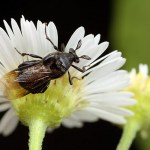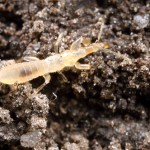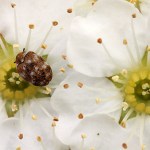entomology
Tonight's challenge is this rather unusual insect.
What is it?
Points will be awarded to the first person to pick the order (3), family (3), and genus (3). Plus, a bonus point for explaining what is unusual about this insect's life cycle.
The cumulative winner for the month of June 2010 will get their choice of 1) any 8x10 print from my photo galleries; or 2) a guest post on the safe-for-work topic of their choice.
Mystery #1
I admit, I like to pick on iStockphoto, the pioneering company behind the high volume/low cost microstock model of media licensing.
There's nothing wrong with microstock. After all, the thriving web-based market for cheap images is a ripe opportunity. But buyers get what they pay for, and they should be aware that a photographer who nets forty cents an image is unlikely to fact-check with the same level of rigor as one paid $400 an image. So the microstocks are entertainingly peppered with error.
Tonight's challenge: put a name on each of these ten taxonomic disasters from the…
What was the mystery?
It's a unique-headed bug in the enigmatic family Enicocephalidae. These soil-dwelling insects are predators of other arthropods. They are of phylogenetic interest as a potential sister lineage to the remaining Heteroptera, the true bugs.
Enicocephalids aren't terribly common- I can count on one hand the times I've seen them in the field- and I was most surprised to find one scurrying about under a stone in my small urban front yard.
Five points to James Trager, who first picked the order. And five more to Kojun, who got the family.
Anthrenus sp. carpet beetle
Urbana, Illinois
Little Anthrenus beetles are one of the most common insects across the northern hemisphere. Adults can be found in flowers feasting on pollen, and the detritivorous larvae are often inhabitants of homes and buildings. If you'd like to see one of these yourself, check your window sills- there's a good chance a few will have accumulated around the edges as they try to exit.
A few years ago I attended an organizational meeting for the great Beetle Tree of Life project. A couple dozen of the world's greatest Coleopterists were crammed into a room…
I had an assignment this weekend to shoot preserved insects as if in a museum display collection. Dead bugs aren't normally my thing, but there's something to be said about subjects that stay put and allow me to arrange lighting without scurrying off. I pinned the insects in foam-bottomed trays and reflected the strobe off an overhead white board. More photos below.
Photo details (all): Canon 100mm f2.8 macro lens on a Canon EOS 50D
ISO 100, f5-f11, 1/40 sec, indirect strobe
Ok, so we all know this is a wasp. But what's with the lumps near the tip of the abdomen?
Ten points for identifying the lump, and five points for anyone ambitious enough to put a name on the wasp, too.
Alright, Sherlock. What's going on here?
Five points each for the identity of the big round thing, for the insect at the top, and for the insect at the side. Ten points for describing the story.
And a freebie point to anyone who comes up with an idea for what to do with all these points.
This scene was photographed in the fall in southern Illinois. Here are close-ups of the critters:
mystery wasp #1
mystery wasp#2
Mark this on your calendar: February 27 is the 27th annual Insect Fear Film Festival. Hosted by the entomology graduate students at the University of Illinois at Urbana-Champaign, the festival showcases two (usually terrible) arthropod movies. This year's delectable offerings are The Black Scorpion (1957) and Ice Crawlers (2003).
If bad movies aren't your thing, the festival also has an insect art competition, live insect displays, face painting, and other buggy entertainment. As way of a preview, Jo-anne posted her pics of last years event here. I've put the full…
tags: biology, zoology, insects, Dragonfly, Wandering Glider, Globe Skimmer, Pantala flavescens, migration, Maldives, India, TEDTalks, TED Talks, Charles Anderson, streaming video
While living and working as a marine biologist in Maldives, Charles Anderson noticed sudden explosions of dragonflies at certain times of year. He explains how he carefully tracked the path of a plain, little dragonfly called the Globe Skimmer, Pantala flavescens, only to discover that it had the longest migratory journey of any insect in the world.
TEDTalks is a daily video podcast of the best talks and…
We've returned from the 2009 Entomological Society of America meeting in Indianapolis. More on this later.
For now, here are slides from two presentations I gave yesterday:
Character Evolution in Heterospilus
Origin of Pheidole obscurithorax
Both talks report from ongoing research, so I should caution that neither of the studies has seen peer-review.
The annual Entomological Society of America meeting is next week (Dec 13-16) in Indianapolis. I'm giving two presentations- one on Pheidole and one on Heterospilus- that the sadistic conference organizers scheduled for the very last day when no one is around.  So if you are attending and happen to miss your flight out, consider heading back to the conference center to catch my talks.
The 2009 meeting will be a good one for we social insect people. I am especially looking forward to the Hoelldobler & Wilson symposium, but the rest of the program is packed with…
Andy Deans of NCSU rightly rakes ASU over the coals for their Ugly Bugs contest:
Denigrating insect species, broadly labeled here as bugs does a disservice to those of us who fight daily to convince a skeptical public...
Over at IB401, the entomology students are blogging faster than a swarm of locusts in a candy shop*:
Caterpillars I have known
Beetle's Threat to Baseball
Ants on Stilts
Pink Mantids!
Keeping a Praying Mantis
Fig Wasp Beats Deforestation
Hungry Crickets
Drop by and leave them some comments!
*or, whatever.
This week, Minnow and I present "Where do Insects Live?" in the Science Emergent Readers Series, from which we've previously featured a book on oceans.
(Yes, I am using bugs in the colloquial sense and not just to refer to some Hemiptera.There's plenty of time for Minnow to learn those details later. Who knows, she may go on to a career in entomology.)
It's autumn in Mystery State and bugs are getting harder to find, but Minnow and I did see various bugs under a flower pot, ants on our sidewalk, and a spider on her swing set. On a walk with SciGram, Minnow also found a moth warming up on a…
Chlaenius sp. ground beetle, Urbana, Illinois
This colorful beetle came from our back yard. It's a ground beetle in the genus Chlaenius, recognizeable from its pubescent elytra and pungent defensive secretions. Like most ground beetles, Chlaenius makes a living as a predator.
The beetle's metallic sheen is not the result of a pigment but of fine microscopic sculpturing on the integument. This is evident when the insect is viewed at a different aspect: notice how the color turns to green in lateral view:
The same beetle, in sideview.
photo details: Canon 100mm f2.8…
A student at the University of Illinois navigates an aphid swarm between classes.
We've had plenty of traffic here at the Myrmecos Blog as bewildered midwesterners look for answers about the swarm of tiny insects that has descended on our cities this week. As best as we can tell, here's the scoop.
Q: What are the annoying little bugs that are swarming Central Illinois this week?
A: They are soybean aphids (Aphis glycines). These small insects feed in summer on soybeans, overwinter as eggs on buckthorn (Rhamnus spp.), and feed in spring on Buckthorn before flying back to soy.…
This week, Public Radio International is hosting a forum whereby you- the fine people of the General Public- get a chance to converse online with eminent entomologist May Berenbaum about all things DDT.
The forum accompanies a piece from last week's "The World". For background, you can read Berenbaum's recent Washington Post essay about the DDT-malaria problem here:
What people aren't remembering about the history of DDT is that, in many places, it failed to eradicate malaria not because of environmentalist restrictions on its use but because it simply stopped working. Insects have a…
I hadn't anticipated that my keen readers would try to guess the *species* of the aforementioned oddity, but since the guessing has headed in that direction I'll post this hint, which shows the much more commonly seen worker caste of our little mystery bug.
Stakes are now at, um, 15 points. Yeah.
This odd little beast crawled out of a leaf litter sample from a mesic oak/pine forest in Florida. Ten points to the first person who picks what it is.
(Not sure what you'll do with ten points. But hey. You're all a creative lot.)
Alaus oculatus (Elateridae) - The Eyed Elater
Illinois
One of North America's largest beetles, the eyed elater is more than an inch long. Alaus oculatus is widespread in the deciduous forests of eastern North America where their larvae are predators of wood-boring beetles. Other species of Alaus occur in the south and west. This individual was attracted to a pheromone trap intended to bring in longhorn beetles as part of a University of Illinois study on beetle pheromones, a ready demonstration of how predators may exploit the chemical signaling of their prey.
This…


